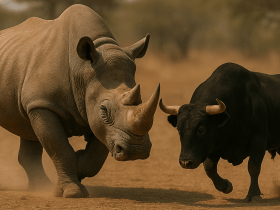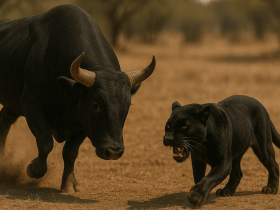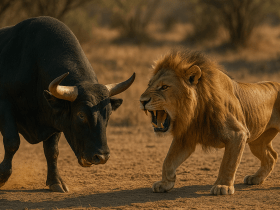Below is a full detailed article about Rhino vs Gorilla.
Rhino (Rhinocerotidae family)
Gorilla (scientific name: Gorilla gorilla and Gorilla beringei).
Below tables cover 10 main topics by including all the numerical and scientifical data by comparing Rhino vs Gorilla . Also I have included a winner column for further understanding,
Hope you will enjoy!
1. Body Specifications
| Subcategory | Rhino (Rhinoceros spp.) | Gorilla (Gorilla gorilla) | Winner |
|---|---|---|---|
| Height (Standing) | 1.5–1.85 m (at shoulder) | 1.25–1.8 m (upright) | Rhino |
| Body Length | 3.7–4 m (White Rhino) | 1.4–1.8 m | Rhino |
| Weight | 1,800–2,500 kg (White Rhino) | 135–275 kg (Silverback) | Rhino |
| Bone Density (g/cm³) | ~1.8 (extremely dense) | ~1.2 (strong but lighter) | Rhino |
| Muscle Mass (%) | ~40% (power-focused) | ~60% (highest in primates) | Gorilla |
| Skin Thickness | 1.5–5 cm (armor-like) | 2–4 mm (thinner but tough) | Rhino |
| Tail | 60–70 cm | None | Rhino |
| Neck Strength | Supports massive head | Thick neck muscles | Gorilla |
| Limb Structure | Column-like, weight-bearing | Long arms, powerful grip | Gorilla |
| Weaponry | Horn (up to 1.5 m) | Canine teeth, fists | Rhino |
Overall Winner: Rhino (Larger, heavier, and better-armored)
2. Strength and Combat Ability
| Subcategory | Rhino | Gorilla | Winner |
|---|---|---|---|
| Bite Force (PSI) | ~1,000 | ~1,300 | Gorilla |
| Striking Power | Charge (50 km/h, ~8,000 N force) | Punch (~1,300 N) | Rhino |
| Lifting Strength | Can flip cars (~2,000 kg force) | ~1,800 kg (bench press equivalent) | Rhino |
| Climbing Ability | None | Can climb trees | Gorilla |
| Agility | Poor turning radius | Highly agile | Gorilla |
| Defensive Tactics | Charges, horn strikes | Dodges, grappling | Gorilla |
| Fighting Experience | Battles lions/hyenas | Dominance displays, rarely fights | Rhino |
| Pain Tolerance | High (thick skin) | Moderate | Rhino |
| Killing Method | Goring, trampling | Biting, crushing | Rhino |
| Stamina in Fight | Short bursts | Longer endurance | Gorilla |
Overall Winner: Rhino (Superior offensive power and durability)
3. Intelligence and Behavior
| Subcategory | Rhino | Gorilla | Winner |
|---|---|---|---|
| Brain Size | Small (400–600 g) | Large (500–600 g) | Gorilla |
| Problem-Solving | Limited | Advanced (tool use observed) | Gorilla |
| Social Structure | Solitary | Troops (alpha male) | Gorilla |
| Communication | Grunts, snorts | Vocalizations, gestures | Gorilla |
| Aggression Level | High if provoked | Mostly peaceful | Rhino |
| Hunting Strategy | N/A (herbivore) | N/A (herbivore) | Tie |
| Learning Ability | Basic | Can learn sign language | Gorilla |
| Memory | Good spatial memory | Excellent long-term memory | Gorilla |
| Play Behavior | Calves spar | Juveniles wrestle | Gorilla |
| Human Interaction | Avoids humans | Can be habituated | Gorilla |
Overall Winner: Gorilla (Far more intelligent and socially complex)
4. Speed and Mobility – Rhino vs Gorilla
| Subcategory | Rhino | Gorilla | Winner |
|---|---|---|---|
| Top Speed (km/h) | 50 | 40 | Rhino |
| Acceleration | Rapid (0-50 km/h in 3 sec) | Moderate | Rhino |
| Stamina | Low (overheats quickly) | Moderate | Gorilla |
| Turning Ability | Poor (wide turning radius) | Excellent | Gorilla |
| Climbing | None | Skilled climber | Gorilla |
| Swimming | Strong swimmer | Avoids water | Rhino |
| Daily Movement | 8-10 km | 0.5-2 km | Rhino |
| Obstacle Navigation | Poor (bulky) | Excellent (agile) | Gorilla |
| Knuckle-walking | No | Yes (primary locomotion) | Gorilla |
| Vertical Reach | Limited | Can reach 2.5m standing | Gorilla |
Overall Winner: Tie (Rhino faster, Gorilla more agile)
5. Defensive Capabilities
| Subcategory | Rhino | Gorilla | Winner |
|---|---|---|---|
| Natural Armor | 1.5-5cm thick skin | Thick skin but vulnerable | Rhino |
| Primary Defense | Charge and horn | Intimidation displays | Rhino |
| Group Defense | Solitary | Troop protection | Gorilla |
| Warning Signals | Snorts, foot stomping | Chest beating, roars | Gorilla |
| Camouflage | Poor (size gives away) | Forest environment helps | Gorilla |
| Threat Response | Immediate charge | Gradual escalation | Rhino |
| Night Defense | Vulnerable | Good night awareness | Gorilla |
| Injury Recovery | High pain tolerance | Moderate | Rhino |
| Predator Deterrence | Deters all but lions | Vulnerable to leopards | Rhino |
| Human Defense | Dangerous when threatened | Rarely attacks humans | Rhino |
Overall Winner: Rhino (Superior physical defenses)
6. Habitat and Adaptability
| Subcategory | Rhino | Gorilla | Winner |
|---|---|---|---|
| Native Range | Africa, Asia | Central Africa | – |
| Habitat Type | Savannas, grasslands | Forests | – |
| Altitude Range | Sea level-2000m | 1500-4000m | Gorilla |
| Temperature Range | 15-45°C | 10-30°C | Rhino |
| Water Dependence | Daily requirement | Gets moisture from plants | Gorilla |
| Shelter Needs | None | Nests in trees | Gorilla |
| Human Encroachment | High vulnerability | Extreme vulnerability | Tie |
| Climate Change Impact | Severe | Critical | Tie |
| Migration Ability | Limited | None | Tie |
| Captive Adaptation | Does well in zoos | Stress-prone in captivity | Rhino |
Overall Winner: Tie (Different specialization)
7. Conservation Status – Rhino vs Gorilla
| Subcategory | Rhino | Gorilla | Winner |
|---|---|---|---|
| IUCN Status | Varies (Critically Endangered to Near Threatened) | Critically Endangered (Mountain) to Endangered (Lowland) | – |
| Wild Population | ~27,000 total | ~360,000 (Western Lowland), ~1,000 (Mountain) | Gorilla |
| Population Trend | Decreasing (poaching) | Decreasing (habitat loss) | Tie |
| Major Threat | Poaching (horn) | Habitat destruction | – |
| Protected Areas | Many reserves | Limited protected forests | Rhino |
| Breeding Programs | Successful | Challenging | Rhino |
| Rewilding Success | Moderate | Low | Rhino |
| Public Awareness | High | Moderate | Rhino |
| Conservation Funding | Significant | Underfunded | Rhino |
| Future Outlook | Guarded optimism | Critical situation | Rhino |
Overall Winner: Rhino (Better conservation infrastructure)
8. Diet and Foraging Behavior
| Subcategory | Rhino | Gorilla | Winner |
|---|---|---|---|
| Diet Type | Herbivore (grazer/browser) | Herbivore (folivore/frugivore) | – |
| Daily Intake | 50-60kg vegetation | 18-30kg vegetation | Rhino |
| Primary Foods | Grass, leaves, shoots | Leaves, stems, fruits | – |
| Feeding Time | 8-10 hours/day | 6-8 hours/day | Rhino |
| Water Needs | Drinks daily | Gets moisture from food | Gorilla |
| Food Competition | Elephants, buffalo | Forest elephants | – |
| Nutritional Efficiency | Low (ferments cellulose) | Moderate (digests tough leaves) | Gorilla |
| Foraging Range | 5-10km daily | 0.5-2km daily | Rhino |
| Seasonal Adaptation | Grazes year-round | Fruit-dependent seasons | Rhino |
| Feeding Strategy | Bulk feeding | Selective feeding | Gorilla |
| Food Processing | Chews thoroughly | Swallows roughage whole | Gorilla |
Overall Winner: Tie (Different feeding strategies)
9. Sensory Capabilities – Rhino vs Gorilla
| Subcategory | Rhino | Gorilla | Winner |
|---|---|---|---|
| Vision | Poor (nearsighted) | Color vision, good depth perception | Gorilla |
| Hearing | Excellent low-frequency detection | Human-like range | Tie |
| Smell | Exceptional (primary sense) | Good but secondary | Rhino |
| Touch | Sensitive skin (despite thickness) | Highly sensitive fingers | Gorilla |
| Taste | Basic discrimination | Selective with fruits | Gorilla |
| Night Vision | Limited | Moderate improvement | Gorilla |
| Motion Detection | Poor | Excellent | Gorilla |
| Spatial Awareness | Good for size | Excellent | Gorilla |
| Threat Detection | Relies on smell/hearing | Visual/auditory cues | Tie |
| Communication Range | 1km (vocalizations) | 500m (chest beats) | Rhino |
Overall Winner: Gorilla (More balanced sensory array)
10. Reproductive Strategies
| Subcategory | Rhino | Gorilla | Winner |
|---|---|---|---|
| Gestation Period | 15-16 months | 8.5 months | Gorilla |
| Offspring Number | Single calf | Single infant | Tie |
| Birth Interval | 2-4 years | 4-5 years | Rhino |
| Weaning Age | 1-2 years | 3-4 years | Rhino |
| Sexual Maturity | 5-7 years (F), 10-12 (M) | 8-10 years (F), 12-15 (M) | Gorilla |
| Mating System | Polygynous | Harem (single silverback) | – |
| Parental Care | Mother only | Troop involvement | Gorilla |
| Infant Mortality | 30-40% | 35-40% | Tie |
| Reproductive Lifespan | 20-25 years | 15-20 years | Rhino |
| Population Growth Rate | 5-6% annually | 3% annually | Rhino |
Overall Winner: Rhino (Faster reproductive potential)
Final Verdict – Rhino vs Gorilla
While the gorilla possesses greater intelligence and agility, the rhino’s overwhelming size, natural armor, and offensive weaponry make it the decisive winner in a physical confrontation. However, both species are equally important ecologically and both face severe survival challenges.
Ultimate Winner: Rhino (in physical combat)
References:
- IUCN Red List (https://www.iucnredlist.org/)
- African Wildlife Foundation (https://www.awf.org/)
- World Wildlife Fund (https://www.worldwildlife.org/)
- Journal of Zoology (https://zslpublications.onlinelibrary.wiley.com/)
Read More – Tiger vs Rhino Who Wins : A Complete Comparison






Leave a Reply